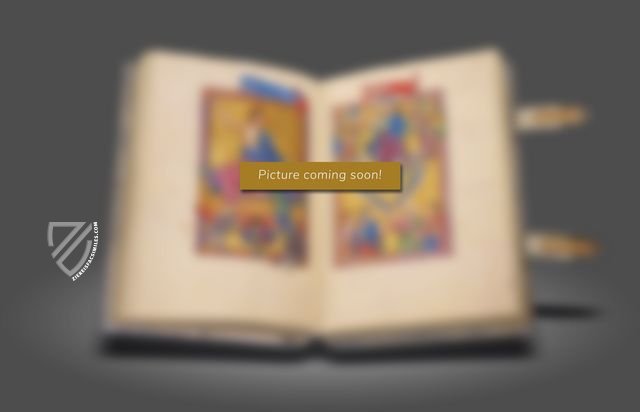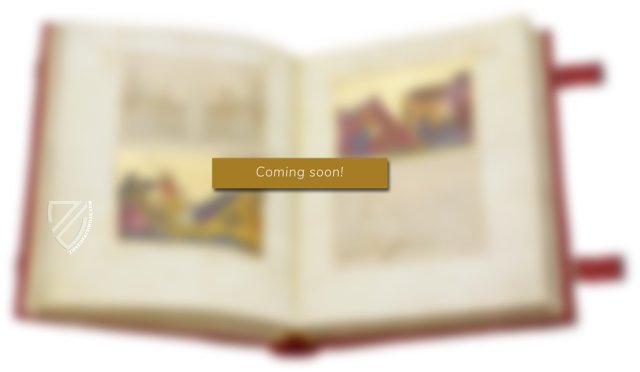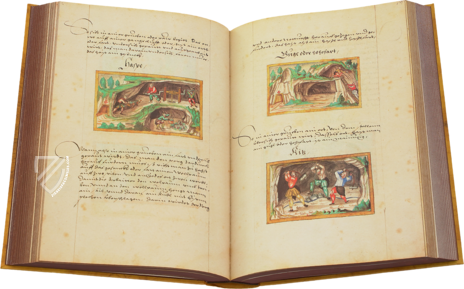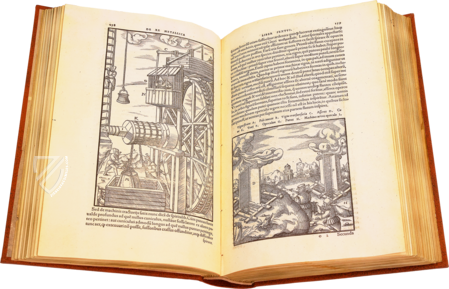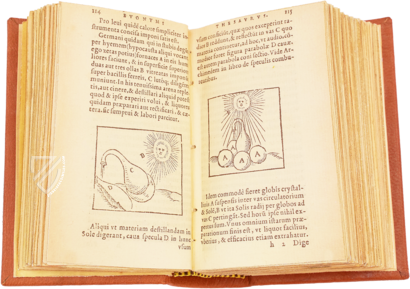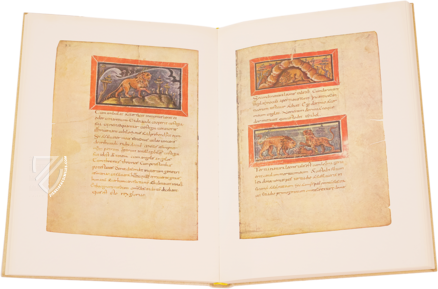Georgius Agricola's De Re Metallica
(under 1,000€)
De Re Metallica is a masterpiece by Georg Bauer (1494-1555), known by the Latinized version of his name: Georgius Agricola. Its content – clear, precise and novel in many aspects – has helped geologists, miners and smelters for centuries. 227 detailed woodcuts by Basilius Weffring, to which he dedicated three years of his life, make the work an artistic treasure as well. Published in 1556, one year after the author’s death, the work has gained the attention and praise of scholars ranging from Erasmus of Rotterdam (1466-1536) to the mining engineer and later President of the United States Herbert Hoover (1874-1964). In collaboration with his wife Lou Henry Hoover (1874-1944), a geologist and Latinist, they completed an authoritative translation into English in 1912, upon which numerous subsequent translations were based. This is the authoritative text on geology, mining and metallurgy and forms a cornerstone of those disciplines today.
Georgius Agricola's De Re Metallica
Knowledge of mining, minerology, and metallurgy was reserved to a small group of professionals and handed down orally from one generation to another across the Middle Ages. A small, cosmopolitan elite was responsible for the construction of great cathedrals and exploring the mysteries of alchemy. This began to change with the Renaissance culture of learning, aided by the invention of the printing press. De Re Metallica is a masterpiece by Georg Bauer (1494-1555), known by the Latinized version of his name: Georgius Agricola. He dedicated the twenty most fruitful years of his life to writing the treatise, and his knowledge of the classics and his status as physician and apothecary ennobled the study of geology and mining. 227 detailed woodcuts by Basilius Weffring, to which he dedicated three years of his life, make the work an artistic treasure as well. Its content – clear, precise and novel in many aspects – has helped geologists, miners, and smelters for centuries. The first edition is presented here and was published in 1556, one year after the author’s death. An authoritative translation into English, upon which numerous subsequent translations were based, was completed in 1912 by the mining engineer and later President of the United States Herbert Hoover (1874-1964) and his wife Lou Henry Hoover (1874-1944), a geologist and Latinist. The translation includes explanations for Agricola's invention of several hundred Latin expressions to cover medieval German mining and milling terms that were unknown to classical Latin.
“The Father of Minerology”
Agricola was gifted with a wonderful intellect and received the equivalent of a modern primary and secondary education in several schools in Glauchau, Zwickau, and Magdeburg. After his studies at the University of Leipzig, he obtained a Bachelor of Arts degree and began his professional activity teaching Greek and Latin. In 1523 he began his medical studies at the University of Leipzig to continue in Bologna and Venice. He was chosen as town physician at Joachimsthal in modern Czechia, a center of mining and smelting works. Agricola returned to Chemnitz, another center of mining, in 1530 after being appointed historiographer by Prince Maurice of Saxony (1521-53). There he held important positions related to politics and administration: mayor, counselor of the Court of Saxony and mediator in the Reformation, between local authorities and Emperor Charles V. The Catholic Agricola was forced to resign as mayor by the Protestant population of Chemnitz, allowing him to retire to private life and focus entirely on his scholarly pursuits. The great humanist Erasmus of Rotterdam (1466-1536) was a fervent admirer of the innovative works of Agricola. Erasmus, as we can read in Bermannus sive de re metallica dialogus, proclaims the uniqueness of Agricola's writings: "such a lucid mind cannot produce anything mediocre."
A Masterpiece in 12 Books
De Re Metallica is divided into twelve books. In them he tells us:
1. The reasons why the study of geology, mining and metallurgy is interesting.
2. The qualities that a miner must possess. The rod to locate those singular points of the earth where the minerals are concentrated.
3. The veins and deposits.
4. The officers of the mines and working conditions.
5. Surveying, fixing, construction of galleries and the search for minerals.
6. The tools, pumps, drains, machinery and diseases of the miners.
7. Methods of assay of minerals in wood and bone ash cups. The muffle furnaces. The process includes the scorification of the pyrite ores, the use of the touchstone and the needles for tests built with the gold, silver and copper alloy.
8. The preparation of minerals: selection, crushing, milling, washing, roasting, and the amalgamation process for gold.
9. It deals with melting furnaces and the preparation of mercury by descent.
10. It describes the separation of gold and silver by cementation, fusion with sulfur or antimony, and the dissolution of silver in nitric acid.
11. Describes the separation of silver from copper and the construction of furnaces. He also talks about the methods used for the rolling of metals and for the manufacture of parts. End this chapter with the procedures to separate iron from silver.
12. Obtaining common salt from both natural solutions and seawater. Obtaining alkaline substances from the ashes of plants. Methods of extraction and purification of saltpeter, alum and vitriol. The manufacture of glass objects.
Codicology
- Alternative Titles
- Georgius Agricolas De Re Metallica
Georgius Agricola. De Re Metallica - Origin
- Switzerland
- Date
- 1556
- Epochs
- Style
- Language
- Content
- Agricola's treatise "On the Nature of Metals (Minerals)"
- Artist / School
- Georg Bauer (pen name: Georgius Agricola) (author)
#1 Georgius Agricola. De Re Metallica
Language: German
(under 1,000€)
- Treatises / Secular Books
- Apocalypses / Beatus
- Astronomy / Astrology
- Bestiaries
- Bibles / Gospels
- Chronicles / History / Law
- Geography / Maps
- Saints' Lives
- Islam / Oriental
- Judaism / Hebrew
- Single Leaf Collections
- Leonardo da Vinci
- Literature / Poetry
- Liturgical Manuscripts
- Medicine / Botany / Alchemy
- Music
- Mythology / Prophecies
- Psalters
- Other Religious Books
- Games / Hunting
- Private Devotion Books
- Other Genres
- Afghanistan
- Armenia
- Austria
- Belgium
- Belize
- Bosnia and Herzegovina
- China
- Colombia
- Costa Rica
- Croatia
- Cyprus
- Czech Republic
- Denmark
- Egypt
- El Salvador
- Ethiopia
- France
- Germany
- Greece
- Guatemala
- Honduras
- Hungary
- India
- Iran
- Iraq
- Israel
- Italy
- Japan
- Jordan
- Kazakhstan
- Kyrgyzstan
- Lebanon
- Liechtenstein
- Luxembourg
- Mexico
- Morocco
- Netherlands
- Palestine
- Panama
- Peru
- Poland
- Portugal
- Romania
- Russia
- Serbia
- Spain
- Sri Lanka
- Sweden
- Switzerland
- Syria
- Tajikistan
- Turkey
- Turkmenistan
- Ukraine
- United Kingdom
- United States
- Uzbekistan
- Vatican City
- A. Oosthoek, van Holkema & Warendorf
- Aboca Museum
- Ajuntament de Valencia
- Akademie Verlag
- Akademische Druck- u. Verlagsanstalt (ADEVA)
- Aldo Ausilio Editore - Bottega d’Erasmo
- Alecto Historical Editions
- Alkuin Verlag
- Almqvist & Wiksell
- Amilcare Pizzi
- Andreas & Andreas Verlagsbuchhandlung
- Archa 90
- Archiv Verlag
- Archivi Edizioni
- Arnold Verlag
- ARS
- Ars Magna
- ArtCodex
- AyN Ediciones
- Azimuth Editions
- Badenia Verlag
- Bärenreiter-Verlag
- Belser Verlag
- Belser Verlag / WK Wertkontor
- Benziger Verlag
- Bernardinum Wydawnictwo
- BiblioGemma
- Biblioteca Apostolica Vaticana (Vaticanstadt, Vaticanstadt)
- Bibliotheca Palatina Faksimile Verlag
- Bibliotheca Rara
- Boydell & Brewer
- Bramante Edizioni
- Bredius Genootschap
- Brepols Publishers
- British Library
- C. Weckesser
- Caixa Catalunya
- Canesi
- CAPSA, Ars Scriptoria
- Caratzas Brothers, Publishers
- Carus Verlag
- Casamassima Libri
- Centrum Cartographie Verlag GmbH
- Chavane Verlag
- Christian Brandstätter Verlag
- Circulo Cientifico
- Club Bibliófilo Versol
- Club du Livre
- CM Editores
- Collegium Graphicum
- Collezione Apocrifa Da Vinci
- Comissão Nacional para as Comemorações dos Descobrimentos Portugueses
- Coron Verlag
- Corvina
- CTHS
- D. S. Brewer
- Damon
- De Agostini/UTET
- De Nederlandsche Boekhandel
- De Schutter
- Deuschle & Stemmle
- Deutscher Verlag für Kunstwissenschaft
- DIAMM
- Droz
- E. Schreiber Graphische Kunstanstalten
- Ediciones Boreal
- Ediciones Grial
- Ediclube
- Edições Inapa
- Edilan
- Editalia
- Edition Deuschle
- Edition Georg Popp
- Edition Leipzig
- Edition Libri Illustri
- Editiones Reales Sitios S. L.
- Éditions de l'Oiseau Lyre
- Editions Medicina Rara
- Editorial Casariego
- Editorial Mintzoa
- Editrice Antenore
- Editrice Velar
- Edizioni Edison
- Egeria, S.L.
- Eikon Editores
- Electa
- Emery Walker Limited
- Enciclopèdia Catalana
- Eos-Verlag
- Ephesus Publishing
- Ernst Battenberg
- Eugrammia Press
- Extraordinary Editions
- Fackelverlag
- Facsimila Art & Edition
- Facsimile Editions Ltd.
- Facsimilia Art & Edition Ebert KG
- Faksimile Verlag
- Feuermann Verlag
- Folger Shakespeare Library
- Franco Cosimo Panini Editore
- Friedrich Wittig Verlag
- Fundación Hullera Vasco-Leonesa
- G. Braziller
- Gabriele Mazzotta Editore
- Gebr. Mann Verlag
- Gesellschaft für graphische Industrie
- Getty Research Institute
- Giovanni Domenico de Rossi
- Giunti Editore
- Graffiti
- Grafica European Center of Fine Arts
- Guido Pressler
- Guillermo Blazquez
- Gustav Kiepenheuer
- H. N. Abrams
- Harrassowitz
- Harvard University Press
- Helikon
- Hendrickson Publishers
- Henning Oppermann
- Herder Verlag
- Hes & De Graaf Publishers
- Hoepli
- Holbein-Verlag
- Houghton Library
- Hugo Schmidt Verlag
- Idion Verlag
- Il Bulino, edizioni d'arte
- ILte
- Imago
- Insel Verlag
- Insel-Verlag Anton Kippenberger
- Instituto de Estudios Altoaragoneses
- Instituto Nacional de Antropología e Historia
- Introligatornia Budnik Jerzy
- Istituto dell'Enciclopedia Italiana - Treccani
- Istituto Ellenico di Studi Bizantini e Postbizantini
- Istituto Geografico De Agostini
- Istituto Poligrafico e Zecca dello Stato
- Italarte Art Establishments
- Jan Thorbecke Verlag
- Johnson Reprint Corporation
- Josef Stocker
- Josef Stocker-Schmid
- Jugoslavija
- Karl W. Hiersemann
- Kasper Straube
- Kaydeda Ediciones
- Kindler Verlag / Coron Verlag
- Kodansha International Ltd.
- Konrad Kölbl Verlag
- Kurt Wolff Verlag
- La Liberia dello Stato
- La Linea Editrice
- La Meta Editore
- Lambert Schneider
- Landeskreditbank Baden-Württemberg
- Leo S. Olschki
- Les Incunables
- Liber Artis
- Library of Congress
- Libreria Musicale Italiana
- Lichtdruck
- Lito Immagine Editore
- Lumen Artis
- Lund Humphries
- M. Moleiro Editor
- Maison des Sciences de l'homme et de la société de Poitiers
- Manuscriptum
- Martinus Nijhoff
- Maruzen-Yushodo Co. Ltd.
- MASA
- Massada Publishers
- McGraw-Hill
- Metropolitan Museum of Art
- Militos
- Millennium Liber
- Müller & Schindler
- Nahar - Stavit
- Nahar and Steimatzky
- National Library of Wales
- Neri Pozza
- Nova Charta
- Oceanum Verlag
- Odeon
- Orbis Mediaevalis
- Orbis Pictus
- Österreichische Staatsdruckerei
- Oxford University Press
- Pageant Books
- Parzellers Buchverlag
- Patrimonio Ediciones
- Pattloch Verlag
- PIAF
- Pieper Verlag
- Plon-Nourrit et cie
- Poligrafiche Bolis
- Presses Universitaires de Strasbourg
- Prestel Verlag
- Princeton University Press
- Prisma Verlag
- Priuli & Verlucca, editori
- Pro Sport Verlag
- Propyläen Verlag
- Pytheas Books
- Quaternio Verlag Luzern
- Reales Sitios
- Recht-Verlag
- Reichert Verlag
- Reichsdruckerei
- Reprint Verlag
- Riehn & Reusch
- Roberto Vattori Editore
- Rosenkilde and Bagger
- Roxburghe Club
- Salerno Editrice
- Saltellus Press
- Sandoz
- Sarajevo Svjetlost
- Schöck ArtPrint Kft.
- Schulsinger Brothers
- Scolar Press
- Scrinium
- Scripta Maneant
- Scriptorium
- Shazar
- Siloé, arte y bibliofilia
- SISMEL - Edizioni del Galluzzo
- Sociedad Mexicana de Antropología
- Société des Bibliophiles & Iconophiles de Belgique
- Soncin Publishing
- Sorli Ediciones
- Stainer and Bell
- Studer
- Styria Verlag
- Sumptibus Pragopress
- Szegedi Tudomànyegyetem
- Taberna Libraria
- Tarshish Books
- Taschen
- Tempus Libri
- Testimonio Compañía Editorial
- Thames and Hudson
- The Clear Vue Publishing Partnership Limited
- The Facsimile Codex
- The Folio Society
- The Marquess of Normanby
- The Richard III and Yorkist History Trust
- Tip.Le.Co
- TouchArt
- TREC Publishing House
- TRI Publishing Co.
- Trident Editore
- Tuliba Collection
- Typis Regiae Officinae Polygraphicae
- Union Verlag Berlin
- Universidad de Granada
- University of California Press
- University of Chicago Press
- Urs Graf
- Vallecchi
- Van Wijnen
- VCH, Acta Humaniora
- VDI Verlag
- VEB Deutscher Verlag für Musik
- Verlag Anton Pustet / Andreas Verlag
- Verlag Bibliophile Drucke Josef Stocker
- Verlag der Münchner Drucke
- Verlag für Regionalgeschichte
- Verlag Styria
- Vicent Garcia Editores
- W. Turnowski Ltd.
- W. Turnowsky
- Waanders Printers
- Wiener Mechitharisten-Congregation (Wien, Österreich)
- Wissenschaftliche Buchgesellschaft
- Wissenschaftliche Verlagsgesellschaft
- Wydawnictwo Dolnoslaskie
- Xuntanza Editorial
- Zakład Narodowy
- Zollikofer AG

